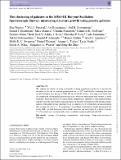Files in this item
The clustering of galaxies in the SDSS-III Baryon Oscillation Spectroscopic Survey : measuring structure growth using passive galaxies
Item metadata
| dc.contributor.author | Tojeiro, R. | |
| dc.contributor.author | Percival, W. J. | |
| dc.contributor.author | Brinkmann, J. | |
| dc.contributor.author | Brownstein, J. R. | |
| dc.contributor.author | Eisenstein, D. J. | |
| dc.contributor.author | Manera, M. | |
| dc.contributor.author | Maraston, C. | |
| dc.contributor.author | McBride, C. K. | |
| dc.contributor.author | Muna, D. | |
| dc.contributor.author | Reid, B. | |
| dc.contributor.author | Ross, A. J. | |
| dc.contributor.author | Ross, N. P. | |
| dc.contributor.author | Samushia, L. | |
| dc.contributor.author | Padmanabhan, N. | |
| dc.contributor.author | Schneider, D. P. | |
| dc.contributor.author | Skibba, R. | |
| dc.contributor.author | Sánchez, A. G. | |
| dc.contributor.author | Swanson, M. E. C. | |
| dc.contributor.author | Thomas, D. | |
| dc.contributor.author | Tinker, J. L. | |
| dc.contributor.author | Verde, L. | |
| dc.contributor.author | Wake, D. A. | |
| dc.contributor.author | Weaver, B. A. | |
| dc.contributor.author | Zhao, G.-B. | |
| dc.date.accessioned | 2018-10-16T11:30:07Z | |
| dc.date.available | 2018-10-16T11:30:07Z | |
| dc.date.issued | 2012-08-11 | |
| dc.identifier | 252559671 | |
| dc.identifier | c2fdc2f2-bced-41d8-8f23-8e0605c63de4 | |
| dc.identifier | 84864518558 | |
| dc.identifier.citation | Tojeiro , R , Percival , W J , Brinkmann , J , Brownstein , J R , Eisenstein , D J , Manera , M , Maraston , C , McBride , C K , Muna , D , Reid , B , Ross , A J , Ross , N P , Samushia , L , Padmanabhan , N , Schneider , D P , Skibba , R , Sánchez , A G , Swanson , M E C , Thomas , D , Tinker , J L , Verde , L , Wake , D A , Weaver , B A & Zhao , G-B 2012 , ' The clustering of galaxies in the SDSS-III Baryon Oscillation Spectroscopic Survey : measuring structure growth using passive galaxies ' , Monthly Notices of the Royal Astronomical Society , vol. 424 , no. 3 , pp. 2339-2344 . https://doi.org/10.1111/j.1365-2966.2012.21404.x | en |
| dc.identifier.issn | 0035-8711 | |
| dc.identifier.other | Bibtex: urn:bafcca6ae6327f3a55c4bb5aadced830 | |
| dc.identifier.uri | https://hdl.handle.net/10023/16230 | |
| dc.description.abstract | We explore the benefits of using a passively evolving population of galaxies to measure the evolution of the rate of structure growth between z = 0.25 and 0.65 by combining data from the Sloan Digital Sky Survey (SDSS) I/II and SDSS-III surveys. The large-scale linear bias of a population of dynamically passive galaxies, which we select from both surveys, is easily modelled. Knowing the bias evolution breaks degeneracies inherent to other methodologies, and decreases the uncertainty in measurements of the rate of structure growth and the normalization of the galaxy power spectrum by up to a factor of 2. If we translate our measurements into a constraint on σ8(z = 0) assuming a concordance cosmological model and general relativity (GR), we find that using a bias model improves our uncertainty by a factor of nearly 1.5. Our results are consistent with a flat Λ cold dark matter model and with GR. | |
| dc.format.extent | 6 | |
| dc.format.extent | 337782 | |
| dc.language.iso | eng | |
| dc.relation.ispartof | Monthly Notices of the Royal Astronomical Society | en |
| dc.subject | Surveys | en |
| dc.subject | Cosmology: observations | en |
| dc.subject | Dark energy | en |
| dc.subject | Large-scale structure of Universe | en |
| dc.subject | QB Astronomy | en |
| dc.subject | QC Physics | en |
| dc.subject.lcc | QB | en |
| dc.subject.lcc | QC | en |
| dc.title | The clustering of galaxies in the SDSS-III Baryon Oscillation Spectroscopic Survey : measuring structure growth using passive galaxies | en |
| dc.type | Journal article | en |
| dc.contributor.institution | University of St Andrews. School of Physics and Astronomy | en |
| dc.identifier.doi | https://doi.org/10.1111/j.1365-2966.2012.21404.x | |
| dc.description.status | Peer reviewed | en |
This item appears in the following Collection(s)
Items in the St Andrews Research Repository are protected by copyright, with all rights reserved, unless otherwise indicated.

